+ Open data
Open data
- Basic information
Basic information
| Entry |  | |||||||||
|---|---|---|---|---|---|---|---|---|---|---|
| Title | Cryo-EM structure of 186bp ALBN1 nucleosome aided by scFv | |||||||||
 Map data Map data | Main map | |||||||||
 Sample Sample |
| |||||||||
 Keywords Keywords | nucleosome / pioneer transcription factors / DNA binding proteins / transcription / chromatin / NUCLEAR PROTEIN / NUCLEAR PROTEIN-DNA complex | |||||||||
| Function / homology |  Function and homology information Function and homology informationnegative regulation of tumor necrosis factor-mediated signaling pathway / negative regulation of megakaryocyte differentiation / protein localization to CENP-A containing chromatin / Chromatin modifying enzymes / Replacement of protamines by nucleosomes in the male pronucleus / CENP-A containing nucleosome / Packaging Of Telomere Ends / Recognition and association of DNA glycosylase with site containing an affected purine / Cleavage of the damaged purine / Deposition of new CENPA-containing nucleosomes at the centromere ...negative regulation of tumor necrosis factor-mediated signaling pathway / negative regulation of megakaryocyte differentiation / protein localization to CENP-A containing chromatin / Chromatin modifying enzymes / Replacement of protamines by nucleosomes in the male pronucleus / CENP-A containing nucleosome / Packaging Of Telomere Ends / Recognition and association of DNA glycosylase with site containing an affected purine / Cleavage of the damaged purine / Deposition of new CENPA-containing nucleosomes at the centromere / nucleosomal DNA binding / Recognition and association of DNA glycosylase with site containing an affected pyrimidine / Cleavage of the damaged pyrimidine / Inhibition of DNA recombination at telomere / telomere organization / Meiotic synapsis / Interleukin-7 signaling / RNA Polymerase I Promoter Opening / epigenetic regulation of gene expression / Assembly of the ORC complex at the origin of replication / SUMOylation of chromatin organization proteins / Regulation of endogenous retroelements by the Human Silencing Hub (HUSH) complex / DNA methylation / Condensation of Prophase Chromosomes / SIRT1 negatively regulates rRNA expression / Chromatin modifications during the maternal to zygotic transition (MZT) / HCMV Late Events / ERCC6 (CSB) and EHMT2 (G9a) positively regulate rRNA expression / innate immune response in mucosa / PRC2 methylates histones and DNA / Regulation of endogenous retroelements by KRAB-ZFP proteins / Defective pyroptosis / Regulation of endogenous retroelements by Piwi-interacting RNAs (piRNAs) / HDACs deacetylate histones / RNA Polymerase I Promoter Escape / Nonhomologous End-Joining (NHEJ) / lipopolysaccharide binding / Transcriptional regulation by small RNAs / Formation of the beta-catenin:TCF transactivating complex / RUNX1 regulates genes involved in megakaryocyte differentiation and platelet function / NoRC negatively regulates rRNA expression / Activated PKN1 stimulates transcription of AR (androgen receptor) regulated genes KLK2 and KLK3 / G2/M DNA damage checkpoint / HDMs demethylate histones / B-WICH complex positively regulates rRNA expression / DNA Damage/Telomere Stress Induced Senescence / heterochromatin formation / PKMTs methylate histone lysines / Metalloprotease DUBs / Meiotic recombination / Pre-NOTCH Transcription and Translation / RMTs methylate histone arginines / Activation of anterior HOX genes in hindbrain development during early embryogenesis / HCMV Early Events / Transcriptional regulation of granulopoiesis / structural constituent of chromatin / UCH proteinases / antimicrobial humoral immune response mediated by antimicrobial peptide / nucleosome / antibacterial humoral response / nucleosome assembly / E3 ubiquitin ligases ubiquitinate target proteins / Recruitment and ATM-mediated phosphorylation of repair and signaling proteins at DNA double strand breaks / chromatin organization / RUNX1 regulates transcription of genes involved in differentiation of HSCs / Factors involved in megakaryocyte development and platelet production / HATs acetylate histones / Processing of DNA double-strand break ends / gene expression / Senescence-Associated Secretory Phenotype (SASP) / Oxidative Stress Induced Senescence / defense response to Gram-negative bacterium / Estrogen-dependent gene expression / killing of cells of another organism / chromosome, telomeric region / Ub-specific processing proteases / defense response to Gram-positive bacterium / cadherin binding / protein heterodimerization activity / Amyloid fiber formation / negative regulation of cell population proliferation / protein-containing complex / DNA binding / RNA binding / extracellular space / extracellular exosome / extracellular region / nucleoplasm / membrane / nucleus / cytosol Similarity search - Function | |||||||||
| Biological species |  Homo sapiens (human) / Homo sapiens (human) /  | |||||||||
| Method | single particle reconstruction / cryo EM / Resolution: 2.65 Å | |||||||||
 Authors Authors | Zhou BR / Bai Y | |||||||||
| Funding support |  United States, 1 items United States, 1 items
| |||||||||
 Citation Citation |  Journal: Mol Cell / Year: 2024 Journal: Mol Cell / Year: 2024Title: Structural insights into the cooperative nucleosome recognition and chromatin opening by FOXA1 and GATA4. Authors: Bing-Rui Zhou / Hanqiao Feng / Furong Huang / Iris Zhu / Stephanie Portillo-Ledesma / Dan Shi / Kenneth S Zaret / Tamar Schlick / David Landsman / Qianben Wang / Yawen Bai /   Abstract: Mouse FOXA1 and GATA4 are prototypes of pioneer factors, initiating liver cell development by binding to the N1 nucleosome in the enhancer of the ALB1 gene. Using cryoelectron microscopy (cryo-EM), ...Mouse FOXA1 and GATA4 are prototypes of pioneer factors, initiating liver cell development by binding to the N1 nucleosome in the enhancer of the ALB1 gene. Using cryoelectron microscopy (cryo-EM), we determined the structures of the free N1 nucleosome and its complexes with FOXA1 and GATA4, both individually and in combination. We found that the DNA-binding domains of FOXA1 and GATA4 mainly recognize the linker DNA and an internal site in the nucleosome, respectively, whereas their intrinsically disordered regions interact with the acidic patch on histone H2A-H2B. FOXA1 efficiently enhances GATA4 binding by repositioning the N1 nucleosome. In vivo DNA editing and bioinformatics analyses suggest that the co-binding mode of FOXA1 and GATA4 plays important roles in regulating genes involved in liver cell functions. Our results reveal the mechanism whereby FOXA1 and GATA4 cooperatively bind to the nucleosome through nucleosome repositioning, opening chromatin by bending linker DNA and obstructing nucleosome packing. | |||||||||
| History |
|
- Structure visualization
Structure visualization
| Supplemental images |
|---|
- Downloads & links
Downloads & links
-EMDB archive
| Map data |  emd_43193.map.gz emd_43193.map.gz | 33.2 MB |  EMDB map data format EMDB map data format | |
|---|---|---|---|---|
| Header (meta data) |  emd-43193-v30.xml emd-43193-v30.xml emd-43193.xml emd-43193.xml | 25.4 KB 25.4 KB | Display Display |  EMDB header EMDB header |
| FSC (resolution estimation) |  emd_43193_fsc.xml emd_43193_fsc.xml | 8.4 KB | Display |  FSC data file FSC data file |
| Images |  emd_43193.png emd_43193.png | 166.1 KB | ||
| Filedesc metadata |  emd-43193.cif.gz emd-43193.cif.gz | 6.7 KB | ||
| Others |  emd_43193_additional_1.map.gz emd_43193_additional_1.map.gz emd_43193_additional_2.map.gz emd_43193_additional_2.map.gz emd_43193_half_map_1.map.gz emd_43193_half_map_1.map.gz emd_43193_half_map_2.map.gz emd_43193_half_map_2.map.gz | 32.5 MB 32.5 MB 59.3 MB 59.3 MB | ||
| Archive directory |  http://ftp.pdbj.org/pub/emdb/structures/EMD-43193 http://ftp.pdbj.org/pub/emdb/structures/EMD-43193 ftp://ftp.pdbj.org/pub/emdb/structures/EMD-43193 ftp://ftp.pdbj.org/pub/emdb/structures/EMD-43193 | HTTPS FTP |
-Validation report
| Summary document |  emd_43193_validation.pdf.gz emd_43193_validation.pdf.gz | 825.4 KB | Display |  EMDB validaton report EMDB validaton report |
|---|---|---|---|---|
| Full document |  emd_43193_full_validation.pdf.gz emd_43193_full_validation.pdf.gz | 824.9 KB | Display | |
| Data in XML |  emd_43193_validation.xml.gz emd_43193_validation.xml.gz | 16.2 KB | Display | |
| Data in CIF |  emd_43193_validation.cif.gz emd_43193_validation.cif.gz | 21 KB | Display | |
| Arichive directory |  https://ftp.pdbj.org/pub/emdb/validation_reports/EMD-43193 https://ftp.pdbj.org/pub/emdb/validation_reports/EMD-43193 ftp://ftp.pdbj.org/pub/emdb/validation_reports/EMD-43193 ftp://ftp.pdbj.org/pub/emdb/validation_reports/EMD-43193 | HTTPS FTP |
-Related structure data
| Related structure data | 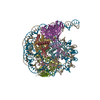 8vfxMC 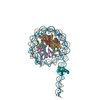 8vfyC  8vfzC 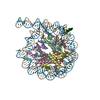 8vg0C 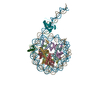 8vg1C M: atomic model generated by this map C: citing same article ( |
|---|---|
| Similar structure data | Similarity search - Function & homology  F&H Search F&H Search |
- Links
Links
| EMDB pages |  EMDB (EBI/PDBe) / EMDB (EBI/PDBe) /  EMDataResource EMDataResource |
|---|---|
| Related items in Molecule of the Month |
- Map
Map
| File |  Download / File: emd_43193.map.gz / Format: CCP4 / Size: 64 MB / Type: IMAGE STORED AS FLOATING POINT NUMBER (4 BYTES) Download / File: emd_43193.map.gz / Format: CCP4 / Size: 64 MB / Type: IMAGE STORED AS FLOATING POINT NUMBER (4 BYTES) | ||||||||||||||||||||||||||||||||||||
|---|---|---|---|---|---|---|---|---|---|---|---|---|---|---|---|---|---|---|---|---|---|---|---|---|---|---|---|---|---|---|---|---|---|---|---|---|---|
| Annotation | Main map | ||||||||||||||||||||||||||||||||||||
| Projections & slices | Image control
Images are generated by Spider. | ||||||||||||||||||||||||||||||||||||
| Voxel size | X=Y=Z: 1.2375 Å | ||||||||||||||||||||||||||||||||||||
| Density |
| ||||||||||||||||||||||||||||||||||||
| Symmetry | Space group: 1 | ||||||||||||||||||||||||||||||||||||
| Details | EMDB XML:
|
-Supplemental data
-Additional map: Class 3
| File | emd_43193_additional_1.map | ||||||||||||
|---|---|---|---|---|---|---|---|---|---|---|---|---|---|
| Annotation | Class 3 | ||||||||||||
| Projections & Slices |
| ||||||||||||
| Density Histograms |
-Additional map: Class 2
| File | emd_43193_additional_2.map | ||||||||||||
|---|---|---|---|---|---|---|---|---|---|---|---|---|---|
| Annotation | Class 2 | ||||||||||||
| Projections & Slices |
| ||||||||||||
| Density Histograms |
-Half map: Half map A
| File | emd_43193_half_map_1.map | ||||||||||||
|---|---|---|---|---|---|---|---|---|---|---|---|---|---|
| Annotation | Half map A | ||||||||||||
| Projections & Slices |
| ||||||||||||
| Density Histograms |
-Half map: Half map B
| File | emd_43193_half_map_2.map | ||||||||||||
|---|---|---|---|---|---|---|---|---|---|---|---|---|---|
| Annotation | Half map B | ||||||||||||
| Projections & Slices |
| ||||||||||||
| Density Histograms |
- Sample components
Sample components
-Entire : 186bp ALBN1 nucleosome in complex with scFv
| Entire | Name: 186bp ALBN1 nucleosome in complex with scFv |
|---|---|
| Components |
|
-Supramolecule #1: 186bp ALBN1 nucleosome in complex with scFv
| Supramolecule | Name: 186bp ALBN1 nucleosome in complex with scFv / type: complex / ID: 1 / Parent: 0 / Macromolecule list: all |
|---|---|
| Source (natural) | Organism:  Homo sapiens (human) Homo sapiens (human) |
-Macromolecule #1: Histone H3.1
| Macromolecule | Name: Histone H3.1 / type: protein_or_peptide / ID: 1 / Number of copies: 2 / Enantiomer: LEVO |
|---|---|
| Source (natural) | Organism:  Homo sapiens (human) Homo sapiens (human) |
| Molecular weight | Theoretical: 15.437167 KDa |
| Recombinant expression | Organism:  |
| Sequence | String: MARTKQTARK STGGKAPRKQ LATKAARKSA PATGGVKKPH RYRPGTVALR EIRRYQKSTE LLIRKLPFQR LVREIAQDFK TDLRFQSSA VMALQEACEA YLVGLFEDTN LCAIHAKRVT IMPKDIQLAR RIRGERA UniProtKB: Histone H3.1 |
-Macromolecule #2: Histone H4
| Macromolecule | Name: Histone H4 / type: protein_or_peptide / ID: 2 / Number of copies: 2 / Enantiomer: LEVO |
|---|---|
| Source (natural) | Organism:  Homo sapiens (human) Homo sapiens (human) |
| Molecular weight | Theoretical: 11.394426 KDa |
| Recombinant expression | Organism:  |
| Sequence | String: MSGRGKGGKG LGKGGAKRHR KVLRDNIQGI TKPAIRRLAR RGGVKRISGL IYEETRGVLK VFLENVIRDA VTYTEHAKRK TVTAMDVVY ALKRQGRTLY GFGG UniProtKB: Histone H4 |
-Macromolecule #3: Histone H2A type 1-B/E
| Macromolecule | Name: Histone H2A type 1-B/E / type: protein_or_peptide / ID: 3 / Number of copies: 2 / Enantiomer: LEVO |
|---|---|
| Source (natural) | Organism:  Homo sapiens (human) Homo sapiens (human) |
| Molecular weight | Theoretical: 14.165551 KDa |
| Recombinant expression | Organism:  |
| Sequence | String: MSGRGKQGGK ARAKAKTRSS RAGLQFPVGR VHRLLRKGNY SERVGAGAPV YLAAVLEYLT AEILELAGNA ARDNKKTRII PRHLQLAIR NDEELNKLLG RVTIAQGGVL PNIQAVLLPK KTESHHKAKG K UniProtKB: Histone H2A type 1-B/E |
-Macromolecule #4: Histone H2B type 1-J
| Macromolecule | Name: Histone H2B type 1-J / type: protein_or_peptide / ID: 4 / Number of copies: 2 / Enantiomer: LEVO |
|---|---|
| Source (natural) | Organism:  Homo sapiens (human) Homo sapiens (human) |
| Molecular weight | Theoretical: 13.935239 KDa |
| Recombinant expression | Organism:  |
| Sequence | String: MPEPAKSAPA PKKGSKKAVT KAQKKDGKKR KRSRKESYSI YVYKVLKQVH PDTGISSKAM GIMNSFVNDI FERIAGEASR LAHYNKRST ITSREIQTAV RLLLPGELAK HAVSEGTKAV TKYTSAK UniProtKB: Histone H2B type 1-J |
-Macromolecule #5: scFv
| Macromolecule | Name: scFv / type: protein_or_peptide / ID: 5 / Number of copies: 2 / Enantiomer: LEVO |
|---|---|
| Source (natural) | Organism:  |
| Molecular weight | Theoretical: 29.34542 KDa |
| Recombinant expression | Organism:  |
| Sequence | String: MKSSHHHHHH ENLYFQSNAM DIKMTQSPSS MHASLGERVT ITCKASQDIR SYLSWYQQKP WKSPKTLIYY ATSLADGVPS RFSGSGSGQ DFSLTINNLE SDDTATYYCL QHGESPYTFG SGTKLEIKRA GGGGSGGGGS GGGGSGGGGS MEVQLQQSGP E LVEPGTSV ...String: MKSSHHHHHH ENLYFQSNAM DIKMTQSPSS MHASLGERVT ITCKASQDIR SYLSWYQQKP WKSPKTLIYY ATSLADGVPS RFSGSGSGQ DFSLTINNLE SDDTATYYCL QHGESPYTFG SGTKLEIKRA GGGGSGGGGS GGGGSGGGGS MEVQLQQSGP E LVEPGTSV KMPCKASGYT FTSYTIQWVK QTPRQGLEWI GYIYPYNAGT KYNEKFKGKA TLTSDKSSST VYMELSSLTS ED SAVYYCA RKSSRLRSTL DYWGQGTSVT VSS |
-Macromolecule #6: DNA (158-MER)
| Macromolecule | Name: DNA (158-MER) / type: dna / ID: 6 / Number of copies: 1 / Classification: DNA |
|---|---|
| Source (natural) | Organism: synthetic construct (others) |
| Molecular weight | Theoretical: 57.399637 KDa |
| Sequence | String: (DA)(DT)(DC)(DC)(DG)(DA)(DG)(DA)(DT)(DG) (DG)(DT)(DA)(DC)(DT)(DT)(DT)(DG)(DT)(DG) (DT)(DC)(DT)(DC)(DC)(DT)(DG)(DC)(DT) (DC)(DT)(DG)(DT)(DC)(DA)(DG)(DC)(DA)(DG) (DG) (DG)(DC)(DA)(DC)(DT)(DG) ...String: (DA)(DT)(DC)(DC)(DG)(DA)(DG)(DA)(DT)(DG) (DG)(DT)(DA)(DC)(DT)(DT)(DT)(DG)(DT)(DG) (DT)(DC)(DT)(DC)(DC)(DT)(DG)(DC)(DT) (DC)(DT)(DG)(DT)(DC)(DA)(DG)(DC)(DA)(DG) (DG) (DG)(DC)(DA)(DC)(DT)(DG)(DT)(DA) (DC)(DT)(DT)(DG)(DC)(DT)(DG)(DA)(DT)(DA) (DC)(DC) (DA)(DG)(DG)(DG)(DA)(DA)(DT) (DG)(DT)(DT)(DT)(DG)(DT)(DT)(DC)(DT)(DT) (DA)(DA)(DA) (DT)(DA)(DC)(DC)(DA)(DT) (DC)(DA)(DT)(DT)(DC)(DC)(DG)(DG)(DA)(DC) (DG)(DT)(DG)(DT) (DT)(DT)(DG)(DC)(DC) (DT)(DT)(DG)(DG)(DC)(DC)(DA)(DG)(DT)(DT) (DT)(DT)(DC)(DC)(DA) (DT)(DG)(DT)(DA) (DC)(DA)(DT)(DG)(DC)(DA)(DG)(DA)(DA)(DA) (DG)(DA)(DA)(DG)(DT)(DT) (DT)(DG)(DG) (DA)(DC)(DT)(DG)(DA)(DT)(DC)(DA)(DA)(DT) (DA)(DC)(DA)(DG)(DT)(DC)(DC) (DT)(DC) (DT)(DG)(DC)(DC)(DT)(DT)(DT)(DA)(DA)(DA) (DG)(DC)(DA)(DA)(DT)(DA)(DG)(DG) (DA) (DA)(DA)(DG)(DA)(DT) |
-Macromolecule #7: DNA (158-MER)
| Macromolecule | Name: DNA (158-MER) / type: dna / ID: 7 / Number of copies: 1 / Classification: DNA |
|---|---|
| Source (natural) | Organism: synthetic construct (others) |
| Molecular weight | Theoretical: 57.42777 KDa |
| Sequence | String: (DA)(DT)(DC)(DT)(DT)(DT)(DC)(DC)(DT)(DA) (DT)(DT)(DG)(DC)(DT)(DT)(DT)(DA)(DA)(DA) (DG)(DG)(DC)(DA)(DG)(DA)(DG)(DG)(DA) (DC)(DT)(DG)(DT)(DA)(DT)(DT)(DG)(DA)(DT) (DC) (DA)(DG)(DT)(DC)(DC)(DA) ...String: (DA)(DT)(DC)(DT)(DT)(DT)(DC)(DC)(DT)(DA) (DT)(DT)(DG)(DC)(DT)(DT)(DT)(DA)(DA)(DA) (DG)(DG)(DC)(DA)(DG)(DA)(DG)(DG)(DA) (DC)(DT)(DG)(DT)(DA)(DT)(DT)(DG)(DA)(DT) (DC) (DA)(DG)(DT)(DC)(DC)(DA)(DA)(DA) (DC)(DT)(DT)(DC)(DT)(DT)(DT)(DC)(DT)(DG) (DC)(DA) (DT)(DG)(DT)(DA)(DC)(DA)(DT) (DG)(DG)(DA)(DA)(DA)(DA)(DC)(DT)(DG)(DG) (DC)(DC)(DA) (DA)(DG)(DG)(DC)(DA)(DA) (DA)(DC)(DA)(DC)(DG)(DT)(DC)(DC)(DG)(DG) (DA)(DA)(DT)(DG) (DA)(DT)(DG)(DG)(DT) (DA)(DT)(DT)(DT)(DA)(DA)(DG)(DA)(DA)(DC) (DA)(DA)(DA)(DC)(DA) (DT)(DT)(DC)(DC) (DC)(DT)(DG)(DG)(DT)(DA)(DT)(DC)(DA)(DG) (DC)(DA)(DA)(DG)(DT)(DA) (DC)(DA)(DG) (DT)(DG)(DC)(DC)(DC)(DT)(DG)(DC)(DT)(DG) (DA)(DC)(DA)(DG)(DA)(DG)(DC) (DA)(DG) (DG)(DA)(DG)(DA)(DC)(DA)(DC)(DA)(DA)(DA) (DG)(DT)(DA)(DC)(DC)(DA)(DT)(DC) (DT) (DC)(DG)(DG)(DA)(DT) |
-Experimental details
-Structure determination
| Method | cryo EM |
|---|---|
 Processing Processing | single particle reconstruction |
| Aggregation state | particle |
- Sample preparation
Sample preparation
| Buffer | pH: 7.5 |
|---|---|
| Vitrification | Cryogen name: ETHANE |
- Electron microscopy
Electron microscopy
| Microscope | TFS KRIOS |
|---|---|
| Image recording | Film or detector model: GATAN K3 (6k x 4k) / Average electron dose: 1.0 e/Å2 |
| Electron beam | Acceleration voltage: 300 kV / Electron source:  FIELD EMISSION GUN FIELD EMISSION GUN |
| Electron optics | Illumination mode: OTHER / Imaging mode: OTHER / Nominal defocus max: 1.8 µm / Nominal defocus min: 0.8 µm |
| Experimental equipment |  Model: Titan Krios / Image courtesy: FEI Company |
 Movie
Movie Controller
Controller



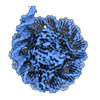













 Z (Sec.)
Z (Sec.) Y (Row.)
Y (Row.) X (Col.)
X (Col.)





















































